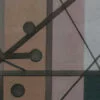Pinned above my desk is a dainty postcard reproduction of Francis Bacon’s Study for Bullfight No. 1. Something in that painting’s brash, cartoon-backdrop colours of marmalade and yellow and lilac has itched at me since I first saw it in an exhibition in London. Something in its swirling, inky, entwined figures of bull and matador wouldn’t leave me alone. And then one day, what this something was struck: it reminded me of Gaelic football, of playing Gaelic football, because football had the same ferocity as captured in Bacon’s canvas. It was faceless and somatic, it was loud colours and frenzy, it was bodies colliding and touching and mixing together. A grand public spectacle while equally being a private contest. The painting encapsulates the fury of competition.
In Gaelic football there are fifteen players on each team. You can kick the ball, you can pick it up in your hands, you can fist it on. Slotting the ball between the tall posts above the goal is one point, snug in the net is three. The sport is steadfastly amateur, from under-twelves all the way to the televised senior intercounty matches in Croke Park stadium with its eighty thousand spectators. Unlike other team sports, in Gaelic football each outfield player, all twenty-eight plotted about the pitch, faces their own one-on-one duel: a specific patch of field to cover and, with that, a specific person to mark and impede, a specific person to evade and fool. It is a team game that is run on individual contests, basically: for instance, if the full forward for the red team has had an excellent match, the full back for the blue team has had an awful one.
When I played, I was a defender: the steered bull and not the glamorous, feather-footed matador. My physique guaranteed this position rather than glaring talent – I was broad and chubby and then broad and less chubby. So the majority of my time on a pitch was spent mirroring my opponent, the attacking player, concentrating on his movements and any sudden muscular twitches, speculating on their intentions and whether they might dash forward, or swerve in behind, or dart infield or, or, or. To be a defender in football is to follow the lead set by another, and it’s a paradoxical relationship. Intimate and erotic – lots of grabbing and pulling and yanking of jersey, a mingling of sweat, the spit and spitting, the command growled from the sideline to be tight to your attacker, you can hear the rhythm of their breathing and catch too how it clicks and wheezes just so after a sprint – and yet, also, instantaneously venomous and incredibly spiteful: I shook hands with the attacker, I took note of the number on his back and then I banged my shoulder against his, once, twice, and in my heart, my deepest, purest wish was to humiliate this fella over the course of the next sixty minutes. I longed to destroy him.
Here is another thing about football: it can be a skilful game, it can be played by artful and technically gifted players – pop ‘Ciaran McDonald’ into YouTube and witness the glory of that bleached blonde mop and knee-high socks and those swerving, outside-of-the-boot pings – but it is fundamentally a physical and aggressive one, and to be successful as a defender means embracing that physical and aggressive edge. Not only in terms of brawn and fitness, not only in the tenacity required to faithfully shadow an attacker as they shuffle to and fro – no, to be a defender of any cop, of any real use, you have to be a little cuntish and brutal. I am not an angry person; my natural inclination is to defuse rather than confront, but I was cuntish when I played football. Not dirty – I never went for the dark arts, the sly jab to a stomach, the withering line about someone’s sister and mother and what about your bure – but when I tackled, I aimed for the ball and then man: to win possession cleanly first, and then to run through the attacker cleanly second. When I harried and chased and blocked, I deployed my body against an opponent like a blunt and effective instrument: me, who was always so shy, so self-conscious about this same body. I was colder, I was quicker to temper, I snapped back. I felt my physique altered: stronger and faster, yes, that’s easy to imagine, but I also felt – and here is where we get kooky – that my jaw was lower, my neck thicker, my shoulders meatier. I possessed a disorientating rage in my need to be victorious that narrowed my world to a tunnel: just the ball, my opponent, and the bright colours of either team’s jerseys. I don’t recognise the buck who, when sent flying over the sideline after a late hit, retaliated by haring after the culprit and crashing into their back with an elbow, but that was me. I don’t recognise the buck who glared and snarled at the ref while he was being reprimanded, who squared up to other young men over a trip or a shoddy tackle or a disagreement over a sideline ball, but that was me. I don’t recognise the buck who held no shame on a football pitch other than the potential shame of losing, but that was me also. A comical and obsessive desire to win unlocked an ugly part of me, primal and furious. This is what I see when I glance up at Bacon’s Study for Bullfight No. 1, at his bull and disfigured matador: me transformed – hideously, gloriously.
Image © Shelby Murphy Figueroa







